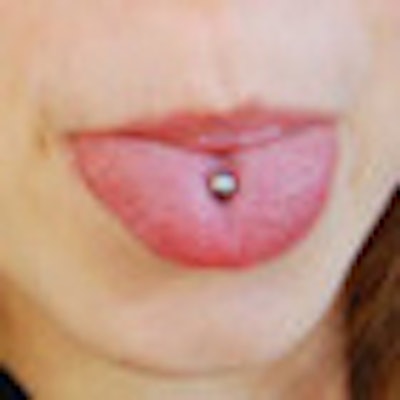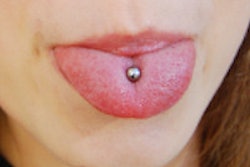
Studies have shown that oral piercings can cause numerous problems in the oral cavity, including chipped, fractured, or cracked teeth and gingival recession. And yet they continue to remain popular with many patients, especially teens.
And although dental practitioners would prefer their patients not get any piercings at all, if the patient insists, dentists can tell them to get plastic jewelry instead of metal because it may be less harmful.
That's the conclusion of a study in the Journal of Adolescent Health (January 18, 2011) that found that stainless steel jewelry can accumulate more bacteria than jewelry made from plastics such as Teflon (polytetrafluoroethylene or PTFE).
“The piercing may cost just $100, but it can cost thousands in orthodontic treatment.”
— Sawsan Tabbaa, DDS
"In our previous study on the prevalence of periodontal complications with median lip piercings (Quintessence, October 2010, Vol. 41:9, pp. 731-737), we observed significant biofilm development on the subjects' own piercings," lead author Ines Kapferer, MD, from the department of restorative and operative dentistry at the Innsbruck Medical University Dental School, told DrBicuspid.com. "Therefore, we were interested in which species colonize on oral piercings and whether biofilms on oral piercings might be a risk for systemic infections or periodontal infections."
While it is not surprising that total bacterial load is higher on titanium and steel piercings than on PTFE or polypropylene piercings, Dr. Kapferer said, this is the first study to consider such a wide range (80) of bacterial species, he noted.
Working with 85 subjects with tongue piercings, Dr. Kapferer and her colleagues conducted baseline dental exams, then randomly allocated the patients to sterile piercings of four different materials: stainless steel, titanium, PTFE, and polypropylene. Two weeks later, the researchers collected and processed microbiological samples from the study participants.
Among their findings:
- Nearly 29% of subjects reported lingual recessions, while 5% reported tooth chipping on one tooth each.
- With the exception of Aggregatibacter actinomycetemcomitans, Fusobacterium nucleatum species, and Parvimonas micra, bacteria associated with periodontitis were not commonly found in the samples from studs or piercing channels.
- Of the 80 bacterial species, 67 were found at significantly higher levels in samples from stainless steel than from PTFE or polypropylene piercings.
- Pathogens found in statistically significant higher counts on stainless steel piercings than polypropylene or PTFE included Pseudomonas aeruginosa, Staphylococcus aureus, Haemophilus influenza, and the paropathogenic species Porphyromonas gingivalis, Eikenella corrodens, Prevotella intermedia, F. nucleatum species, P. micra, and Campylobacter rectus. Also, staphylococci were found on steel and titanium studs, but not on polypropylene and PTFE.
"The low bacterial counts from piercing channels suggest that having a tongue pierced would not contribute to an increased risk for oral infection," the authors concluded. "The present study demonstrated that studs made of steel might promote the development of a biofilm, whereas those made of polytetrafluoroethylene or polypropylene may be rather inert to bacterial colonization."
The finding of staphylococci on steel and titanium studs may suggest an elevated risk for complication if the piercing channel is infected, they added.
Consumers should avoid stainless steel and titanium studs in favor of polypropylene or PTFE because of bacteria and a potentially higher risk of local infection of the piercing channel, as well as the risk of tooth chipping and gingival recession, according to Dr. Kapferer.
"Bacterial transmission has been shown for teeth and dental implants, and it has been shown that sterile dental implants are colonized after insertion within one week with (paropathogenic) bacteria from surrounding teeth," she said. Studs should be removed before the placement of dental implants and for periodontal treatment, especially with the treatment protocol of full-mouth disinfection, she added.
Sawsan Tabbaa, DDS, MS, an assistant professor of orthodontics at the University of Buffalo School of Dental Medicine who has also done research on the adverse effects of oral piercings (Journal of Clinical Orthodontics, July 2010, Vol. 44:7, pp. 426-428), expressed surprise at these results since stainless steel is a smoother surface than PTFE and other plastics.
"I would have expected it to be the other way around and am surprised that stainless steel accumulated more bacteria," she said.
In addition to the infection issue and other potential complications -- including hemorrhage, infection, chipped and fractured teeth, trauma to the gums, and, in the worst cases, brain abscess -- Dr. Tabbaa opposes oral piercings because of their orthodontic implications.
"Teeth can actually move because of habitual movement of the tongue, and both plastic and metal jewelry will do that," she said. "I had a patient who had a piercing, and it had actually moved her teeth and caused a gap. Tell your patients the piercing may cost just $100, but it can cost them thousands in orthodontic treatment."
And although metal is harder, "there is no significant difference between the two materials when it comes to orthodontic side effects," Dr. Tabbaa said. "I had a patient who shifted between plastic and metal and still had a gap in her teeth."
Copyright © 2011 DrBicuspid.com



















